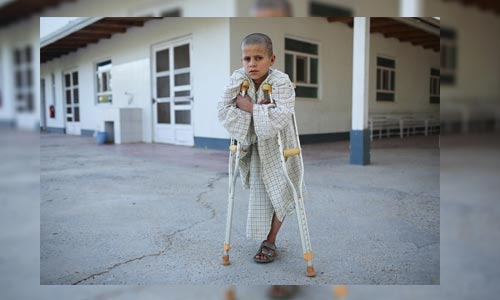Despite constant humanitarian supports, Afghanistan persists to be in the top list of Most Dangerous Conflict place for Children in the world. The longstanding conflict and poverty with worsening displacement crises are of key factors which make the country one of the most dangerous places for children to be born. Globally, According to Save the Children International charity, a US Organization, at least 100,000 babies die every year because of armed conflict and related effects, and Afghanistan listed as being among the 10 worst countries to be a child.“Increasingly, the brunt of armed violence and warfare is being borne by children.” Generally, Children suffer in conflict in different ways to adults because they are physically weaker and their physical, mental, and psychosocial development are heavily affected by the conditions they experience as children.
Thus, a large number of children die in conflict as a result of malnutrition, disease, and lack of health care than from bullets or bombs.” In the five years from 2013-17 in the 10 worst-hit areas, an estimated 550,000 infants died as a result of fighting and the “reverberating impact of conflict.” The figures “suggest that every year in just 10 conflict-affected countries, at least 100,000 infants die in the absence of conflict would survive.” Herein, Afghanistan listed one of the 10 worst countries for children in conflict areas including Iraq, Syria, and Yemen, Central African Republic, Democratic Republic of Congo, Mali, Nigeria, Somalia, and South Sudan.
In Afghanistan alone, as UN verified 3,179 child casualties and it quoted referring to data for infants and older children for 2017. “Many of these incidents involved improvised explosive devices and unexploded ordnance, accounting for at least 33% of those casualties.” The deaths include “children being used to plant bombs and/or to carry out the attacks themselves,” the report quoted. It estimated that nearly 90 percent of children in Yemen, 70 percent of those in Syria, and 60 percent of Somalia’s children were living in close proximity to high-intensity conflict in 2017.
The report noted that the UN Security Council has identified six “grave violations” against children in situations of armed conflict: killing and maiming of children, recruitment and use of children as soldiers, sexual violence against children, abduction of children, attacks on schools and hospitals, and denial of humanitarian access. According to Save the Children, the number of children directly affected by verified cases of grave violations in 2017 was more than 25,000, the highest ever recorded.
“The nature of conflict has changed, putting children in the front line in new and terrible ways,” quoted from the Save the Children Officials. “Wars are lasting longer. They are more likely to be fought in urban areas amongst civilian populations leading to deaths and life-changing injuries, and laying waste to the infrastructure needed to guarantee access to food and water,” it added.
The Save Children Report come Simultaneous with recent UNICEF Humanitarian Action for Children (HAC) 2019 appeal, which highlighted a total of 6.3 million people in dire need of humanitarian support, including 3.8 million children. UNICEF has appealed for US 50 million to provide much needed lifesaving support to more than 570,000 children with basic health and nutrition packages, water, sanitation and hygiene, education and child protection support.
“Despite efforts being made, children continue to bear the brunt of conflict; adverse climatic conditions; unprecedented levels of food insecurity. Some 3 out of 10 children are experiencing psychosocial distress, and some 600,000 children under the age of five years are suffering from severe acute malnutrition,” quoted from Adele Khodr, UNICEF Afghanistan Representative.
Given the various victims that the people are already experiencing, this situation has exacerbated humanitarian needs. In 2018, nearly 289,000 people were verified as newly displaced by conflict, and displacement trends. Up to 39 per cent of the population is poor, 10 million people lack access to essential health services and 3.5 million children (60 per cent of them girls) are out of school. One third of children in Afghanistan have experienced psychological distress related to the loss of family and the constant risk of death or injury due to conflict and attacks on schools. An estimated 2 million children under 5 years are suffering from acute malnutrition, including 600,000 children with severe acute malnutrition (SAM). Persistent conflict has created long-standing socio-economic and development challenges that cannot be addressed through humanitarian assistance alone.
2019 marks 30 years of the Convention on the Rights of the Child (CRC), and 40 years of unrest in Afghanistan. Four decades that has left an ineradicable impact on the country’s children. The safety and wellbeing of Afghanistan’s children is a collective responsibility government and other stakeholders. In addition, the frequent natural disasters like flooding, avalanches and earthquakes take a devastating toll on the children and families of Afghanistan resulting to a large number of people being displaced in 2018.
In general, the long-lasting conflict continues to threaten the physical safety and health of Afghans, disproportionately so for women and children. A large number of people live in conflict affected districts with extremely constrained access to health services. Rates of severe acute malnutrition (SAM) have breached emergency thresholds in many provinces. Simultaneous exposure to violence as well as high economic vulnerability means most households experience multiple and repetitive shocks which result in food insufficiency and adoption of negative, often harmful coping strategies which plunge families deeper into crisis.
Home » Opinion » Afghanistan: the front rank of Dangerous Conflict Zone for Children
Afghanistan: the front rank of Dangerous Conflict Zone for Children
| Mohammad Zahir Akbari

